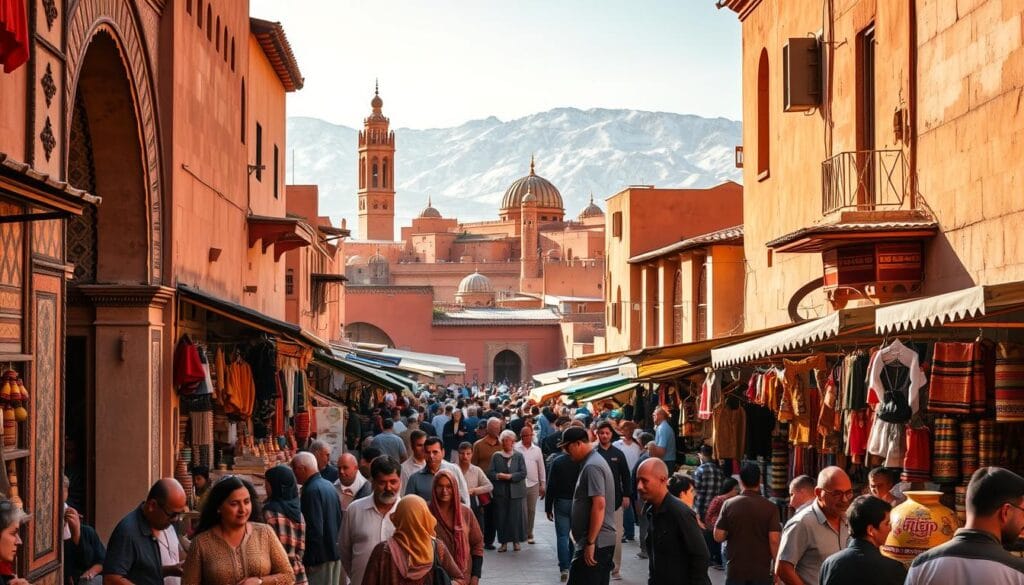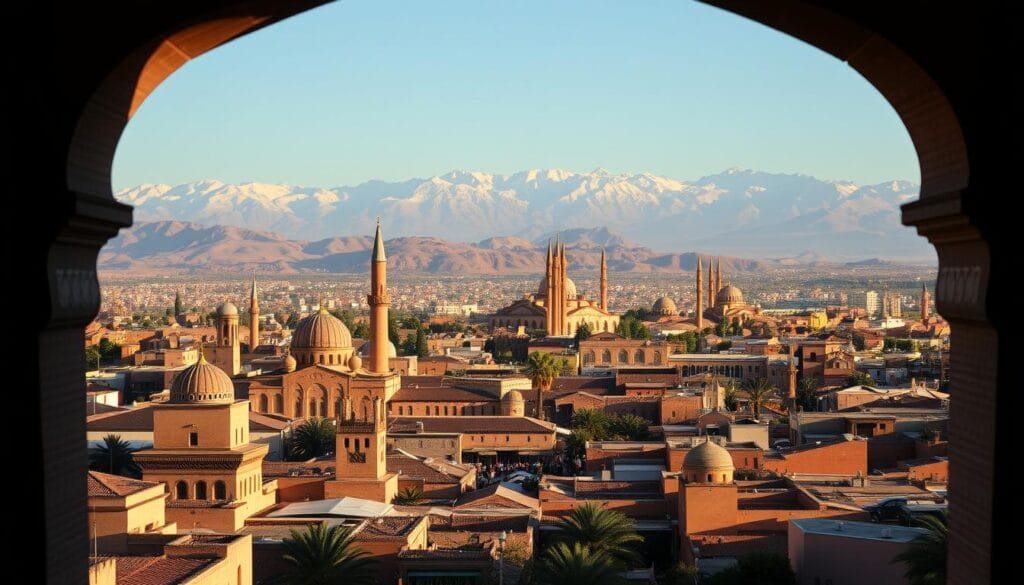Marrakech, a city that embodies the rich tapestry of Moroccan history and culture, is home to over 600 historic landmarks, each telling a unique story of the city’s glorious past.
As local friends sharing authentic experiences, we invite you to explore the vibrant streets and alleys of Marrakech, where ancient traditions seamlessly blend with modern vibrancy. From majestic palaces to bustling souks, the city’s cultural heritage is palpable.
Our journey through Marrakech’s top historical attractions will uncover the secrets and stories behind its most significant sites, showcasing the city’s role as a cultural melting pot.
The Rich Historical Heritage of Marrakech
As we explore Marrakech, we uncover the layers of its historical heritage, a testament to the city’s enduring legacy. Marrakech, known as the Red City, is a city that has been shaped by various cultures and dynasties over the centuries.
The Founding and Evolution of the Red City
Founded in the 11th century, Marrakech has evolved significantly over the years. The city’s strategic location made it an important hub for trade and commerce, attracting people from different parts of the world. As a result, Marrakech’s architecture, cuisine, and culture have been influenced by various cultures, including Arab, Berber, and French.
The city’s historic monuments, such as the Koutoubia Mosque and the Saadian Tombs, are a testament to its rich history. These Marrakech ancient sites have been preserved and restored, allowing visitors to experience the city’s grandeur.
Marrakech’s Role in Moroccan History
Marrakech has played a pivotal role in Moroccan history, serving as the capital city for several dynasties. The city’s strategic importance made it a center of politics, culture, and commerce. As a result, Marrakech has been a hub for Islamic scholarship, with institutions like the Ben Youssef Madrasa attracting students from across the Islamic world.
Today, Marrakech is considered one of the best historical places Marrakech has to offer, with its rich history and cultural heritage making it a popular destination for tourists. Visitors can explore the city’s historic medina, visit its ancient sites, and experience the vibrant culture that defines Marrakech.
The Magnificent Bahia Palace: A 19th Century Masterpiece
In the heart of Marrakech, the Bahia Palace showcases 19th-century craftsmanship, making it one of the top historic attractions Marrakech has to offer. This stunning palace was built for the Grand Vizier Bou Ahmad and is a masterpiece of Moroccan architecture.
The Architectural Splendor and Intricate Details
The Bahia Palace is renowned for its intricate tile work, known as zellij, and its beautifully carved wood ceilings. The palace’s design reflects the finest elements of Islamic architecture, with spacious courtyards and serene gardens providing a tranquil oasis in the bustling city.
The craftsmanship on display is a testament to the skill of Moroccan artisans, who spent years perfecting the intricate details that adorn the palace’s walls and ceilings.
Historical Significance and the Grand Vizier’s Legacy
The Bahia Palace was constructed in the late 19th century as the residence of Grand Vizier Bou Ahmad, who was a powerful figure in the Moroccan court. The palace’s historical significance extends beyond its architectural beauty, representing the political and cultural landscape of Marrakech during that era.
Visitor Tips and Must-See Rooms
When visiting the Bahia Palace, be sure to explore the various rooms and courtyards, each offering a unique glimpse into Marrakech’s rich history. Some of the must-see areas include the grand reception hall, the intricately tiled bathrooms, and the serene gardens.
| Room/Courtyard | Notable Features |
|---|---|
| Grand Reception Hall | Intricately carved wood ceilings, zellij tile work |
| Bathrooms | Intricately tiled, serene atmosphere |
| Gardens | Serene, tranquil oasis |
Visiting the Bahia Palace is an essential experience when exploring must-see historical sites Marrakech. As one of the city’s most significant Marrakech landmarks, it offers a unique insight into the city’s rich cultural heritage.
Koutoubia Mosque: Marrakech’s Iconic Landmark
As we explore the historical treasures of Marrakech, the Koutoubia Mosque stands out as an iconic landmark that embodies the city’s rich cultural heritage. This magnificent structure is not only a must-visit historical site in Marrakech but also a symbol of the city’s spiritual identity.
The History and Architectural Influence of Koutoubia
The Koutoubia Mosque, built in the 12th century, is a masterpiece of Almohad architecture. Its minaret, standing at 69 meters tall, is an exemplary model of Islamic architectural influence in the region. The mosque’s design has inspired numerous other religious structures across North Africa.
The architectural splendor of Koutoubia is characterized by its use of local materials and traditional craftsmanship, reflecting the rich cultural heritage of Marrakech. As one of the famous historical sites Marrakech, it attracts visitors and scholars alike, interested in its historical and architectural significance.
The Minaret’s Role in Marrakech’s Cultural Identity
The minaret of Koutoubia Mosque is more than just an architectural feature; it is a cultural icon that dominates Marrakech’s skyline. It symbolizes the city’s religious and historical identity, serving as a reminder of Marrakech’s importance as a center of Islamic culture and learning.
Best Viewing Points and Photography Opportunities
For those looking to capture the beauty of Koutoubia Mosque, several viewing points around Marrakech offer stunning photography opportunities. The Majorelle Garden and the rooftop terraces of nearby riads provide excellent vantage points, especially during sunrise and sunset when the light enhances the mosque’s majestic appearance.
| Viewing Point | Best Time | Photography Tips |
|---|---|---|
| Majorelle Garden | Early Morning | Use a tripod for stability |
| Rooftop Riads | Sunset | Capture the mosque against a colorful sky |
| Koutoubia Gardens | Late Afternoon | Focus on the minaret’s intricate details |
Visiting the Koutoubia Mosque is an enriching experience that offers insights into Marrakech’s historical and cultural fabric. As one of the Marrakech historical attractions, it is a testament to the city’s enduring legacy and its significance as a cultural and spiritual hub.
El Badi Palace: Exploring the “Incomparable Palace” Ruins
Marrakech’s El Badi Palace, known as the ‘Incomparable Palace,’ is a marvel of historical architecture. This 16th-century palace was once the epitome of luxury and grandeur during the Saadian dynasty. As we explore El Badi Palace, we uncover the layers of history that have shaped Marrakech into the vibrant city it is today.
The Golden Age and Subsequent Decline
El Badi Palace was built in the late 16th century by Sultan Ahmed al-Mansur, celebrating the victory over the Songhai Empire. The palace’s golden age was marked by opulence, with lavish decorations and advanced irrigation systems that supported its lush gardens. However, the palace began to decline shortly after its construction, due in part to the high costs of maintaining such an expansive and intricate complex. Today, visitors can still sense the grandeur that once was, as they wander through the remains.
Navigating the Sunken Gardens and Ancient Walls
As we navigate the sunken gardens and ancient walls of El Badi Palace, we are transported back in time. The palace’s layout, with its expansive courtyards and sophisticated water features, reflects the advanced engineering skills of its builders. Visitors can explore the various sections, including the remains of the pavilions and the impressive ramparts that once fortified the complex. The site offers a unique glimpse into the architectural prowess and aesthetic sensibilities of the Saadian period.
The Minbar and Museum Collections
One of the highlights of visiting El Badi Palace is viewing the exquisite Minbar, a masterpiece of craftsmanship from the 12th century, originally from the Koutoubia Mosque. The palace now houses a museum that showcases various artifacts and art pieces, including intricately carved wooden panels, ornate tiles, and other historical relics. These collections not only highlight the artistic achievements of the era but also provide insight into the cultural and religious practices of the time.
El Badi Palace is a significant historic place in Marrakech, offering a window into the city’s rich past. As one of the key Marrakech heritage sites, it attracts visitors from around the world, drawn to its historical significance and cultural importance. It stands as a testament to Marrakech’s status as a city of Marrakech cultural landmarks, where history and culture converge.
The Saadian Tombs: A Hidden Royal Necropolis
Tucked away in the heart of Marrakech lies a historical gem that remained hidden for centuries: the Saadian Tombs. This royal necropolis is a testament to the city’s rich history and architectural prowess.
The 400-Year Secret and Rediscovery
The Saadian Tombs remained a secret for over 400 years, hidden behind a wall in the Kasbah. It wasn’t until 1917 that they were rediscovered, revealing a treasure trove of historical significance. The tombs date back to the Saadian dynasty, which ruled Morocco from 1554 to 1659.
The rediscovery of the Saadian Tombs was a significant archaeological find, providing insights into the lives of the Saadian sultans and their burial practices.
The Chamber of the Twelve Pillars and Royal Mausoleums
The Saadian Tombs are renowned for their stunning architecture, particularly the Chamber of the Twelve Pillars. This grand hall features 12 marble pillars, intricately carved with Islamic geometric patterns and Quranic inscriptions. The royal mausoleums, with their ornate tile work and carved cedar wood, are a testament to the craftsmanship of the era.
The tombs are divided into several sections, including the Mausoleum of Sultan Ahmad al-Mansur, which is one of the most impressive structures.
| Feature | Description | Significance |
|---|---|---|
| Chamber of the Twelve Pillars | A grand hall with 12 marble pillars | Exemplifies Saadian architectural excellence |
| Royal Mausoleums | Ornate structures with tile work and cedar wood carvings | Reflects the wealth and power of the Saadian dynasty |
| Quranic Inscriptions | Intricate carvings on pillars and walls | Highlights the religious significance of the tombs |
Best Times to Visit and Avoiding Crowds
To make the most of your visit to the Saadian Tombs, consider visiting early in the morning or later in the afternoon to avoid the crowds. The tombs are open from 9 AM to 5 PM, and tickets can be purchased on site.
Visiting during the shoulder season (April-May or September-October) can also help you avoid the peak tourist season crowds, ensuring a more serene experience.
Essential Historical Sites in Marrakech: The Ancient Medina

Marrakech’s Medina, with its labyrinthine alleys and bustling souks, is a living, breathing embodiment of the city’s 1,000-year history. As we explore this ancient heart of Marrakech, we uncover layers of history that have shaped the city into what it is today.
The 1,000-Year-Old UNESCO World Heritage Site
The Medina of Marrakech is not just a historical site; it’s a vibrant, thriving part of the city that has been designated a UNESCO World Heritage Site. With a history spanning over 1,000 years, it stands as a testament to the rich cultural and architectural heritage of Morocco. The Medina’s significance lies not only in its age but also in its ability to preserve the essence of Marrakech’s past while being a living, functioning part of the city.
Historical Gates and Walls of the Medina
The Medina is encircled by ancient walls, punctuated by historic gates that once served as entry points into the city. These gates, such as Bab Agnaou and Bab El Khemis, are not just architectural features but also hold historical significance, telling stories of the city’s past. The walls themselves have witnessed the rise and fall of dynasties and the evolution of Marrakech over the centuries.
Walking Tours and Historical Pathways
To truly experience the Medina’s historical depth, we recommend embarking on a guided walking tour. These tours navigate through the narrow alleys, revealing hidden gems and sharing stories of the landmarks along the way. From the bustling Jemaa el-Fnaa square to the serene Riad courtyards, each step uncovers a piece of Marrakech’s rich tapestry.
As we wander through the Medina, we are not just walking through a historical site; we are immersing ourselves in the living history of Marrakech. The Medina is a must-visit destination for anyone looking to understand the essence of this captivating city.
Ben Youssef Madrasa: Morocco’s Largest Islamic College
As we explore Marrakech’s rich cultural heritage, the Ben Youssef Madrasa stands out as a testament to the city’s historical significance. This ancient Islamic college has been a center of scholarship for seven centuries, attracting visitors from around the world who come to marvel at its beauty and historical importance.
Seven Centuries of Islamic Scholarship
The Ben Youssef Madrasa has a long history of Islamic scholarship, dating back to the 16th century. It was once the largest Islamic college in Morocco, playing a crucial role in the country’s educational and religious landscape. The madrasa’s architecture is a blend of Islamic and Moroccan styles, reflecting the cultural and religious influences of the time. Visitors can explore the intricate details and craftsmanship that adorn the buildings, gaining a deeper understanding of the historical context in which they were constructed.
Geometric Patterns and Quranic Inscriptions
One of the most striking features of the Ben Youssef Madrasa is its intricate geometric patterns and Quranic inscriptions. The walls and ceilings are adorned with beautiful tile work and carved wood, creating a visually stunning experience for visitors. These intricate designs not only add to the aesthetic appeal of the madrasa but also hold significant cultural and religious meaning.
The Student Cells and Courtyard Experience
Visitors to the Ben Youssef Madrasa can explore the student cells, gaining insight into the lives of the scholars who once studied here. The courtyard, with its serene atmosphere, provides a peaceful oasis in the midst of the bustling city. The madrasa’s design and layout reflect the importance of community and learning in Islamic culture, making it a fascinating site to explore.
As one of Marrakech’s must-see historical sites and famous historical sites, the Ben Youssef Madrasa is a cultural landmark that offers a unique glimpse into the city’s rich history and cultural heritage. Whether you’re interested in history, architecture, or simply experiencing the beauty of Marrakech, the Ben Youssef Madrasa is a destination that should not be missed.
Hidden Historical Gems of Marrakech

As we venture beyond Marrakech’s well-known historical sites, we uncover hidden gems that reveal the city’s rich heritage. Marrakech is a city layered with history, and its lesser-known sites offer a fascinating glimpse into its diverse cultural and architectural past.
The Mellah: Marrakech’s Historic Jewish Quarter
The Mellah, Marrakech’s historic Jewish Quarter, is a treasure trove of history. Established in the 16th century, it reflects the city’s once-thriving Jewish community. Visitors can explore the narrow alleys, visit the Slat Al Azama Synagogue, and experience the unique blend of cultures that define this historic area.
The Almoravid Koubba: Marrakech’s Oldest Monument
The Almoravid Koubba is a significant archaeological site, dating back to the 12th century. It is Marrakech’s oldest monument and showcases the city’s early architectural influences. Although partially ruined, it remains an essential piece of Marrakech’s historical puzzle.
Dar Si Said Museum and the Menara Gardens
For art enthusiasts, the Dar Si Said Museum is a must-visit. It houses an impressive collection of Moroccan arts and crafts, including intricate woodwork, jewelry, and textiles. Nearby, the serene Menara Gardens offer a tranquil escape, with their olive groves and tranquil pools. The gardens are a perfect example of traditional Moroccan landscaping.
| Site | Description | Significance |
|---|---|---|
| The Mellah | Historic Jewish Quarter | Cultural diversity and history |
| Almoravid Koubba | 12th-century monument | Marrakech’s oldest monument |
| Dar Si Said Museum | Collection of Moroccan arts | Moroccan craftsmanship |
| Menara Gardens | Traditional Moroccan gardens | Tranquil escape |
Exploring these hidden gems provides a deeper understanding of Marrakech’s complex history and cultural richness. As we wander through these lesser-known sites, we gain a more nuanced appreciation for the city’s heritage and its people.
Conclusion: Preserving the Timeless Beauty of Marrakech
As we conclude our journey through Marrakech’s historical sites, we reflect on the importance of preserving the city’s timeless beauty. Marrakech’s rich cultural heritage, reflected in its numerous historical landmarks, is a treasure that must be cherished and protected for future generations.
Visiting Marrakech’s historical attractions, such as the Bahia Palace and Koutoubia Mosque, is not just about exploring the past; it’s about experiencing the essence of this vibrant city. The historical sites in Marrakech, including the Saadian Tombs and Ben Youssef Madrasa, are testaments to the city’s architectural and cultural heritage.
We hope that our guide has inspired you to explore and appreciate the historical depth and cultural richness of Marrakech. By understanding and respecting the historical significance of these sites, we can all play a role in preserving the beauty and essence of this incredible city for years to come.

